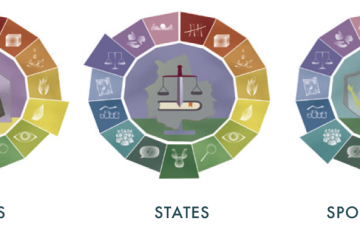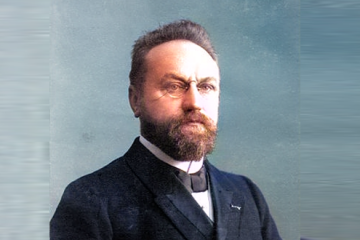Some years ago now, I wrote a post about the relationship between my faith and my love for avant-garde music. One thing I pointed out was the tension between beauty and deliberate discomfort (one might even call it ‘ugliness’) in a lot of this music: I suggested that whilst moments of beauty in avant-garde repertoire were often ‘fleeting but hard-earned’, its ‘free inclusion of sounds that are uncomfortable or even disturbing’ reflected for me ‘an honest response to the beautiful but broken world’ in which we play and hear this music.
That was six years ago; as I look around me now, in 2022, the brokenness of the world is clearer than ever. Although the autumn days here in York are dawning as beautifully bright and crisp as always, the sudden onset of cold weather (after a summer of unprecedented heat and rolling droughts) is coinciding exactly with huge rises in energy bills, widespread inflation, domestic political turmoil, and the ongoing global uncertainty caused by Covid-19 and the deepening crisis in Ukraine. In the midst of such fear and chaos, artistic creativity can seem an impossible luxury, a waste of time and energy that could have been focussed on survival.
And yet in these situations I find myself remembering the famous examples of music created in the midst of crisis: Olivier Messiaen’s Quartet for the End of Time, a set of musical meditations on Revelation that was written and premiered in the German Stalag VIII-A prisoner-of-war camp in 1940; Haydn’s Missa in tempori belli (Mass in Time of War), written in 1796 as the Austrian forces were being driven back by the French revolutionary army; Lewis Allen’s song ‘Strange Fruit’, written in 1939 in response to waves of lynchings of Black Americans, and made famous by Billie Holiday’s performances at the outset of the American civil rights movement. Moments of beauty in these pieces interact with outpourings of fear, anger, confusion, and sorrow; in that sense they continue the Biblical tradition of lament, which provides a space for emotional honesty even when our emotions don’t seem to line up with our theology. (I find it very reassuring that David’s Spirit-inspired words in the Psalms include complaints about God’s perceived distance, inaction and abandonment – and yet he is described as ‘a man after God’s own heart’!)
Art that expresses these painful shared realities can give voice to the hurt of a community, providing catharsis, building unity, or inspiring collective action; it can also remind us of the compassion of Jesus, the ‘man of sorrows’ who bore in himself all of our suffering, and thus understands every hurt that we experience. (One movement of Benjamin Britten’s War Requiem, written for the consecration of the rebuilt Coventry Cathedral in 1962, makes exactly this point by fusing the Agnus Dei with a war poem by Wilfrid Owen that likens the agonies of a dying soldier to those of the crucified Christ.)
As we respond to the sufferings of the world around us, then, let’s be alert to the ways in which artistic creativity can form a part of that response – providing an outlet for all kinds of emotions, including lament.
I wanted to close by sharing one more piece of contemporary music that I’ve been listening to a lot recently: Caroline Shaw’s and the swallow (2017). It’s based on Psalm 84, a song which casts praise as yearning, the desperate desire of the writer to be once more in God’s presence; Shaw’s setting was written in response to the Syrian refugee crisis, and she presents the psalmist’s yearning as a wider longing for home and safety. The piece closes with a haunting evocation of the ‘autumn rains’ of the text, with their promise of long-sought cleansing, refreshment and new life.
- Childlike faith? - December 18, 2024
- God with us - December 19, 2023
- Art in times of crisis - October 3, 2022



3 Comments
Alicia · October 8, 2022 at 10:11 pm
Thank you for this Mark – and for the recommendation of ‘and the swallow’ which is wonderful!
I wonder what the exact relationship is or should be between moral / existential brokenness, and musical / artistic ‘ugliness’ or discomfort – does the latter always ‘represent’ the former, or is that not the right term? I’m thinking in terms of visual art, that there’s a difference between a representation of an evil – maybe something like Guernica – and something deliberately ‘ugly’ or consciously against mainstream standards of artistic beauty, which might be representative in some way of something broken, but equally might not. I guess with music it’s even more complex as it’s less directly representational in the first place.
This is all a question of how terminology equates, or doesn’t, over multiple aspects / spheres – ‘ugly’ and ‘beautiful’ are used both as aesthetic terms, and moral ones, and that leads us to draw connections. But should we do that as easily as we do? Especially as my instinct is that aesthetic standards vary more dramatically than moral ones – although that is definitely an arguable point.
Relatedly, a quotation presented without comment:
‘Beauty is, in some way, boring. Even if its concept changes through the ages… a beautiful object must always follow certain rules. A beautiful nose shouldn’t be longer than that or shorter than that, on the contrary, an ugly nose can be as long as the one of Pinocchio, or as big as the trunk of an elephant, or like the beak of an eagle, and so ugliness is unpredictable, and offers an infinite range of possibility. Beauty is finite, ugliness is infinite like God.’
(Umberto Eco, On the History of Ugliness)
Discuss?!
Mark Hutchinson · October 10, 2022 at 9:59 am
Thanks Alicia, some really challenging observations there! I think you’re absolutely right that equating aesthetic and moral ideas of ‘ugly’ and ‘beautiful’ is a very risky thing to do – in particular since aesthetic standards of taste are so individual (as any lover of avant-garde art of music will know!). As I think about it, it’s interesting that all the pieces of music I list above are linked to crisis or trauma as a kind of response, but not necessarily ‘representative’ of that crisis or trauma; if their sounds ‘represent’ anything specific (and I’m not sure that is always the case), it is the complex of emotions that surrounds the traumatic event, rather than the event itself. And emotions of sadness, anger or fear that follow a morally repugnant event aren’t in themselves necessarily repugnant or ‘ugly’, although they may often be uncomfortable. So now I find myself wondering what the difference is in aesthetic terms between ugliness and discomfort. And that makes me think of the Rilke line about beauty, which seems like a nice counterpart to that wonderful Eco quote: ‘For beauty is nothing but the beginning of terror, which we still are just able to endure, and we are so awed because it serenely disdains to annihilate us. Every angel is terrifying’. (Rilke, Duino Elegies 1) I’ve always found the line itself very beautiful and terrifying at the same time, and very apt in capturing some of the appeal modern art and music have for me; but I’ve also always felt unsure whether I actually believe it to be true… I don’t know how I feel about beauty and terror being so aligned. But I do think it speaks to me of an approach to art and creativity that sees the moments of crisis in the world – the points where everything does feel terrifying or exhausting or sad – as places where art might help us understand something new about the world, or perhaps about God’s character and action within it. Maybe??
Alicia · October 13, 2022 at 2:29 am
Right – the opposite of the idea of art as consolation – using the power that music has to elicit / speak directly to emotion, not to soothe or comfort but to intentionally induce discomfort. (I was at a concert last week that featured Brahms’ Symphony no 4 in E minor, which the conductor introduced by saying that while the ordinary pattern of a symphony is to move tonally from darkness to light, this one doesn’t have light at the end of the tunnel in that way – and indeed it doesn’t let you settle or be thrilled / elated by the end of the work as a lot of big orchestral works would. He connected that to a sense in Brahms’ time of pessimism about the future of society.)
The Rilke quotation seems to be using an idea of beauty that equates for me to the sublime – the feeling of being almost but not quite overwhelmed by something huge and astonishing – and the liminal – being right at the edge of what we can understand / cope with. Very Romantic! And very different to a concept of beauty (that maybe Christians would more often be comfortable with?) that emphasises order, fitness, and harmony. I want to say this is linked to different emphases in our pictures of God – God as the maker and sustainer of the beautifully ordered universe, or the Other who we can only begin to truly know, who is vast and far beyond our categories of understanding.
Tangential question: do you have any examples / a sense of whether or how composers of avant-garde music (not specifically sacred music) are engaging with God, intentionally or not, in their work / approach? That may be too vague to answer properly but I’m thinking about a feeling that I often have when poets / lyricists address a ‘you’ that isn’t specifically defined, that whoever is ‘actually’ being addressed, that kind of address is somehow haunted by the ultimate ‘You’, God as an interlocutor behind all kinds of things we might say or want to say.
Comments are closed.